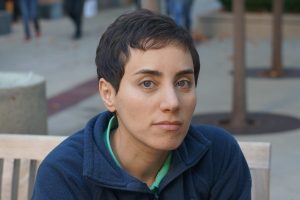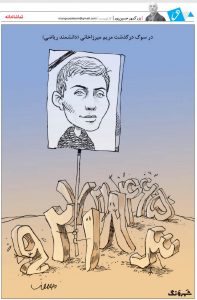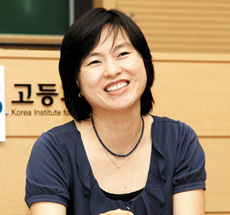
Maryam Mirzakhani. (Photo credit: Stanford University.)
Nine days ago, we lost a bright star of mathematics: Maryam Mirzakhani. Ever since, it seems like the whole world has been in mourning. Many beautiful obituaries have been written in major publications, like Scientific American, the New York Times, and the New Yorker. She has been mourned in social media and blogs, by mathematicians and “civilians” alike. Mathematician-turned-politician Rep. James McNerney gave a tribute on the House floor. Iranian newspapers honored their national hero, some of them even showing her with her head uncovered, breaking long standing hijab rules.

Comic by Bozorgmehr Hosseinpour. Caption reads “In mourning of the passing of Maryam Mirzakhani (Mathematician).” (Translation credit: Shabnam Akhtari.)
I never met Maryam, and yet I feel a huge sense of loss. In trying to understand this feeling I realized that it’s because she changed mathematics for all the women and girls out there, including me — only two years younger than her. Not because I feel like I can accomplish what she did (I don’t!) but because she set the bar, or rather, moved it, for what women can do. We’ve had other math heroines (I know I have many), but in 2014 she achieved something no woman had before: she won the Fields medal. Not only that, she was also widely regarded as an incredibly generous and kind person. And now I find out that while she was achieving these important milestones, she was also in the middle of her quiet fight with an aggressive form of cancer.
I know it’s not fair to put people (real, vulnerable humans) on pedestals, but she did become a symbol of hope for women in math, and we are all feeling that loss together. She was ours. I have seen women in math emailing each other to share the news and their grief, an outpouring of support on the AWM’s facebook page, and math women friends have even reported receiving condolence emails from relatives. I thought about writing a longer piece myself, but honestly all the obituaries I linked to above are so wonderful I didn’t even think I should compete. Instead, I want to have a sort of gathering, a virtual wake, or rather a celebration of her life, and I asked a few friends to help. Below, I have collected some thoughts from women mathematicians expressing how Maryam Mirzakhani changed the mathematical world for them, how she influenced them, and how this influence will live on. Feel free to post your own thoughts, tributes, and anecdotes in the comments section below.
The mathematician

Emily Riehl. Jon Chase/Harvard Staff Photographer
“I saw Maryam Mirzakhani lecture just once but I remember it very clearly. She came to speak in the Current Developments in Mathematics Conference in 2014 at Harvard. Her lecture’s actually available on YouTube. I remember it as one of the most beautiful talks I’ve ever seen. She spends the first half an hour or so introducing a wide variety of interesting mathematical problems before spending the second half connection each to the general theory of dynamics on moduli spaces of curves. One other thing I liked was that she gave a teaser exercise during the talk (see 25:40): namely to prove that the square billiards table is secure, meaning that if a “terrorist” (her terminology) was positioned at any point on the table and could fire a shot in any direction and the “president” (this metaphor works better in 2014..) was positioned at any other position, all possible shots could be blocked by finitely many secret service agents. I thought about this problem off and on for the next several weeks until I worked out the solution. It’s very far from the sort of thing I typically do — I’m a category theorist — which was part of the charm: I was very impressed with how elegant this kind of mathematics is and the generosity of her suggestion of this toy exercise.” – Emily Riehl
The mother

Hee Oh.
“At one of [our] conversations, Maryam asked me whether I have children, and when I answered that I have two, 11 year and 6 year old (that was several years ago as my elder one is now 16), her immediate response was “how did you do that”? At that time her daughter was still a baby. I remember feeling that she was also going through the same kind of life of mom/mathematician that I had experienced several years ahead.
It is a tremendous loss for all of us, but I cannot imagine how hard it must have been for her to leave her daughter.” – Hee Oh
The trailblazer

Izabella Laba.
“Watching Maryam Mirzakhani receive the Fields Medal at the ICM in Seoul will always be one of the highlights of my mathematical life. She became an instant legend, the stories of her life and work reaching far and wide: the IMO gold medals, the stunning Ph.D. thesis, the large sheets of paper spread out on the floor that were her preferred method of work. We all looked forward to her lecture. I was devastated to hear of her illness just a few days later. A mutual friend told me that she would not be speaking and that arrangements had been made with the organizers to let her slip out quietly at the last minute. We were asked to not publicize her health issues, and everyone that I know of respected that until the news broke last week. I did not know about the “MM Shield” that Ingrid Daubechies described for the New Yorker article, but that story is so emblematic of how we’d all go out of our way to protect her.
It was always going to be personal to so many of us. Prior to 2014, the absence of female Fields medalists had been cited widely as evidence that women can’t reach the same mathematical heights that men do. This trickled down to our own mathematical lives; Mirzakhani herself has spoken of a year in school when she was discouraged from mathematics. And yet, when she won the Fields Medal, we were being admonished to refrain from focusing on her gender, as if those other arguments had never existed. That could not be done. She was ours and we were proud of her. We admired her work, her spirit, her courage. We will never know how much more she could have accomplished if her time had not been cut too short.” – Izabella Laba

Jenna Carpenter.
“Maryam was the first woman to receive a Fields Medal (why on earth has no woman ever won one before?!?). Breaking such barriers is always important. She was a phenomenal person to do so and, beyond recognizing her outstanding work, her achievement has elevated the discussion of why our larger community struggles to notice the contributions of young female mathematicians.
Second, my own mother passed away 13 months ago from lung cancer which had spread from breast cancer. She was almost 93 years old and it was her second battle with breast cancer, the first having come 20 years earlier. Having walked with my mom through decades of coping with breast cancer, I have some small idea of what Maryam endured and perhaps why she pursued with vigor the rest of her life, coping quietly with her health issues on the side. It can be a declaration, in a way, that you are not going to let the cancer define you and control your life, as long as you have an ounce of strength to fight it. My own mom remained completely lucid and in-control to the very end, which is just the way she wanted it. Perhaps Maryam did, too.” – Jenna Carpenter
The role model

Yen Duong.
“When Maryam Mirzakhani won the Fields Medal, she jumped to the tip of everyone’s tongues- not just mathematicians. Without meaning to, she raised awareness in the general populace of mathematics and mathematicians, particularly women mathematicians. When I talked to new people and said I was a mathematician, the default response was no longer “Oh, I hated/was really bad at math in high school” (or a variant), but “do you know that woman mathematician who won the math Nobel? I had no idea that a woman hadn’t won it before, or what it was!” I didn’t have to half-heartedly apologize anymore for doing something I love, and there was less math negativity in the world (for at least a while). Of course she profoundly affected many people I know much more deeply, but this one accomplishment of hers affected everybody, including me as a graduate student just beginning my research career. ” – Yen Duong

Tai-Danae Bradley.
“While reading through the many beautifully written tributes to Maryam, I am especially touched by one theme that pervades them all: her character. Words like persistent, determined, and resolute appear time and time again. And her humility and modesty seem to have garnered as much attention as her mathematical accomplishments. Although I never met Maryam personally, this speaks volumes of the strength of her character.
As more and more women and girls learn about Maryam and her story, they will be inspired to pursue mathematics, and they’ll be inspired to pursue it with persistence and humility. They’ll be inspired to ask questions with confidence and assurance. They’ll be inspired to press on when the work seems impossible. And they’ll be inspired to do math simply for the joy and beauty of it.
Tenacity coupled with humility is a particularly potent combination for producing excellent mathematics. And it’s precisely that combination that I hope women and girls across the globe will seek to emulate as they look to Maryam as an example. The future for women in math is an exciting one. And mathematics as a whole will be all the better for it.
What a legacy! We could not have asked for a better role model than Maryam Mirzakhani.” – Tai-Danae Bradley

rest in peace Dera Maryam. The world will not forget such a amazing woman.
God bless your familly, for ever.
Great article! Thanks for including all these stories.